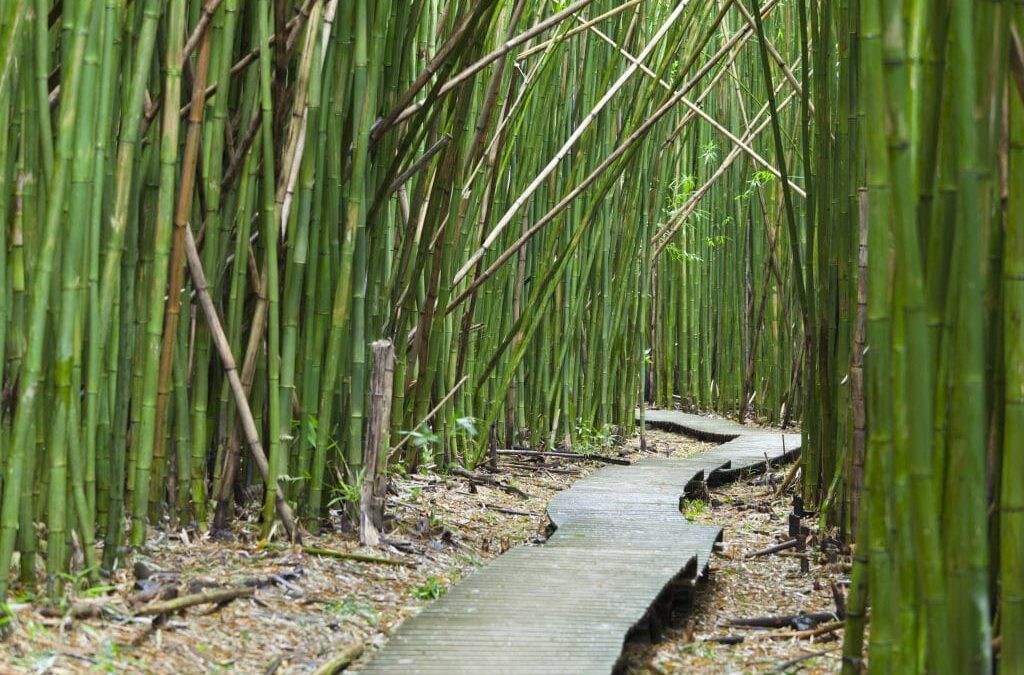-
Despite the tribe of bamboo – included within the Poaceae family – having upwards of 1,600 individual species, and being split between two extremely distinct growth patterns (monopodial and sympodial bamboo), this widely diverse group of woody perennial grasses ends up often being lumped together and talked about in highly generalist terms. While common literature and widely available information generally provides a separation between monopodial and sympodial bamboo species, this often translates into an over simplification into just two categorizations of opposing needs and behavior, that of temperate running bamboo versus tropical clumping bamboo. Similarly, when we talk about the development of bamboo farms or manufacturing across much of Latin America, Africa and Asia, all tropical clumping bamboo species often end up getting grouped together and treated as one. In contrast, the behavior, needs, and requirements of the >1,600 species of bamboo cover an extremely wide diversity, much of which is still under discovery and recording.
The rest of this posting refers only to the poor availability of information towards site species selection for tropical clumping (sympodial) bamboo, as such tropical clumpers are the focus of EcoPlanet Bamboo’s experience, research, and interest.
When we first started working towards bamboo plantation development in 2009 – 2010, we found that the handful of timber bamboo species referred to regularly, and those repeatedly recommended for commercial production, was extremely narrow, and often, equally mis-leading. That situation continues today, with the focus and awareness on species diversity and the important factors to be incorporated into species choice, extremely narrow in scope. In contrast to any generalization, and particularly during the early years of growth and development, tropical clumping bamboo species are extremely fragile and require a species-specific set of growing conditions, from soils types, to pH, to temperature and humidity, to rainfall amounts and patterns. None of the more widely understood tropical clumping bamboo species behave the same, and no two species have identical requirements.
Furthermore, not only does each species have its own requirements, but its growth, development and subsequent yields are a direct result of those growing conditions.
In 2012 when EcoPlanet Bamboo first began the company’s expansion, from our first experience with commercial certified bamboo plantations in Central America, into South Africa with the purchase of the Kowie Bamboo Farm, we were recommended, and indeed strongly urged, by various tissue laboratory facilities, to plant Dendrocalamus asper. Luckily, a little bit of homework along with some research on the growth and yields evidenced by this species in different climates across its native Asia, suggested that Dendrocalamus asper would require far more of a tropical climate than ours… not just a higher rainfall, but also shorter dry seasons, warmer winter temperatures, and an overall higher humidity than our temperate climate in South Africa’s Eastern Cape.
We agreed, however, to plant a few plants as a trial around the boundary of one of our fields, and now, more than four years into the growth of this species, just how wrong a species choice Dendrocalamus asper is for this particular location is extremely evident.
The photos below show 10 clumps, in two lines perpendicular to each. The first image shows, to the left of the gate, four plants that were receiving some run off water from EcoPlanet Bamboo’s nursery (which was previously in the now empty grassy area), while to the right of the gate are a row of clumps that have not received any irrigation and therefore only the approximate 650mm rainfall / year common for this area. Both sets of clumps, although with quite a striking difference, are barely surviving, let alone being close to what would be expected from a five year old bamboo clump of this particular species. These photos were taken just shortly after winter (a mild sub-tropical winter with no frost or freezing), during which the asper plants dry out completely, almost appearing to be dead. Unlike the Bambusa balcooa (which is also a tropical clumping species but with a different set of site requirements) that can be seen in the background, they do not recover as temperatures increase.
Dendrocalamus asper planted in South Africa’s Eastern Cape – a trial of pushing climatic boundaries for this species
Four year old Dendrocalamus asper is extremely stunted and struggling to survive the sub-tropical climate and low rainfall
The above images show what happens when careful and silviculturally rigorous bamboo site-species selection is not carried out. Grown in the wrong climate or the wrong soil type, bamboo plants will simply die, OR they will be so extremely slow growing and stunted that they will never reach any sort of commercial viability.
So where did this myth come from, that bamboo can grow anywhere?
We believe that this isn’t so much a myth as it is a mis-information that has ended up becoming widespread due, quite simply, to one of the major barriers of entry into commercial bamboo farming. That is the availability of quality planting material of a wide range of species. Most tropical clumpers have a unique flowering pattern, making bamboo seed extremely rare and hard to come by. At the same time, tissue culture for bamboo species has really only become widely available in the past five years and remains expensive, poorly understood and only available for a handful of species. When EcoPlanet Bamboo began the company’s commercial bamboo plantations there were only two companies producing tissue culture plantlets with a total of three available species between them. This severe lack of availability of quality planting material at scale and the peverse incentives created by entities whose sole focus as a commercial nursery needing to secure monthly income through the sale of available seedlings, combined with a limited market for the planting of bamboo at scale, is the driving factor behind this widely spread mis-information and the subsequent mis-conception that site-species selection for bamboo is not an important aspect for consideration.
To put it simply, poor site-species selection is often the result of there simply not being any other choice of available planting material. For example, Bambusa vulgaris has been planted across a wide range of geographic, topographical and climatic contexts in the East African nations of Kenya and Rwanda. This species choice has often been a straightforward result of this being the only source of planting material, from parent material already widely occurring (although not native) around each country.
However, site-species selection, and a careful consideration of a range of factors, including as detailed above, soil type, pH, rainfall amounts and patterns, and temperature and humidity, are critical if a bamboo plant, farm or plantation is to be commercially viable.
In contrast to the barely hanging on plants in the Eastern Cape, the below images show the same species, Dendrocalamus asper, when grown in the correct site conditions. These plants are four years younger than those above, and yet under the right site selection are healthy, thriving plants, well on their way to producing culms of a healthy diameter. There is no doubt that under the right conditions, this particular species has the potential to be extremely high yielding and productive.
Healthy one year old Dendrocalamus asper thriving in Ghana’s tropical climate
This one year old Dendrocalamus asper seedling is proving right all of the positive myths about bamboo’s extremely fast growth rates, and has put out healthy woody culms within its first shooting season, just months after being transplanted from the nursery into the field. While those in the Eastern Cape continue to struggle, these in the correct tropical climate will be ready to enter a sustainable harvest regime as soon as they hit maturity, somewhere around year five.
The above images of Dendrocalamus asper have been used only as a single example to highlight that bamboo cannot and should not be referred to or lumped into a single categorization. While some species might be able to tolerate a wider range of climates, soils, and growing conditions, such as the widely planted Bambusa vulgaris, most species have a relatively small range with specific requirements.
While a species might survive in conditions outside of its ideal range, its ability to produce and sustain large yields of a healthy biomass each year, will be directly impacted as conditions change or vary outside of this range.
In the next bamboo plantation article we will discuss the related issue of site-product selection, an issue that is as important for the planting of bamboo, whether for commercial bamboo farms, plantations or under smallholder farmer plantings. This posting will address the mis-conception that all bamboo species can be utilized for the same product.
Source: https://www.ecoplanetbambooplantations.com/single-post/bamboo-site-species-selection


Recent Comments